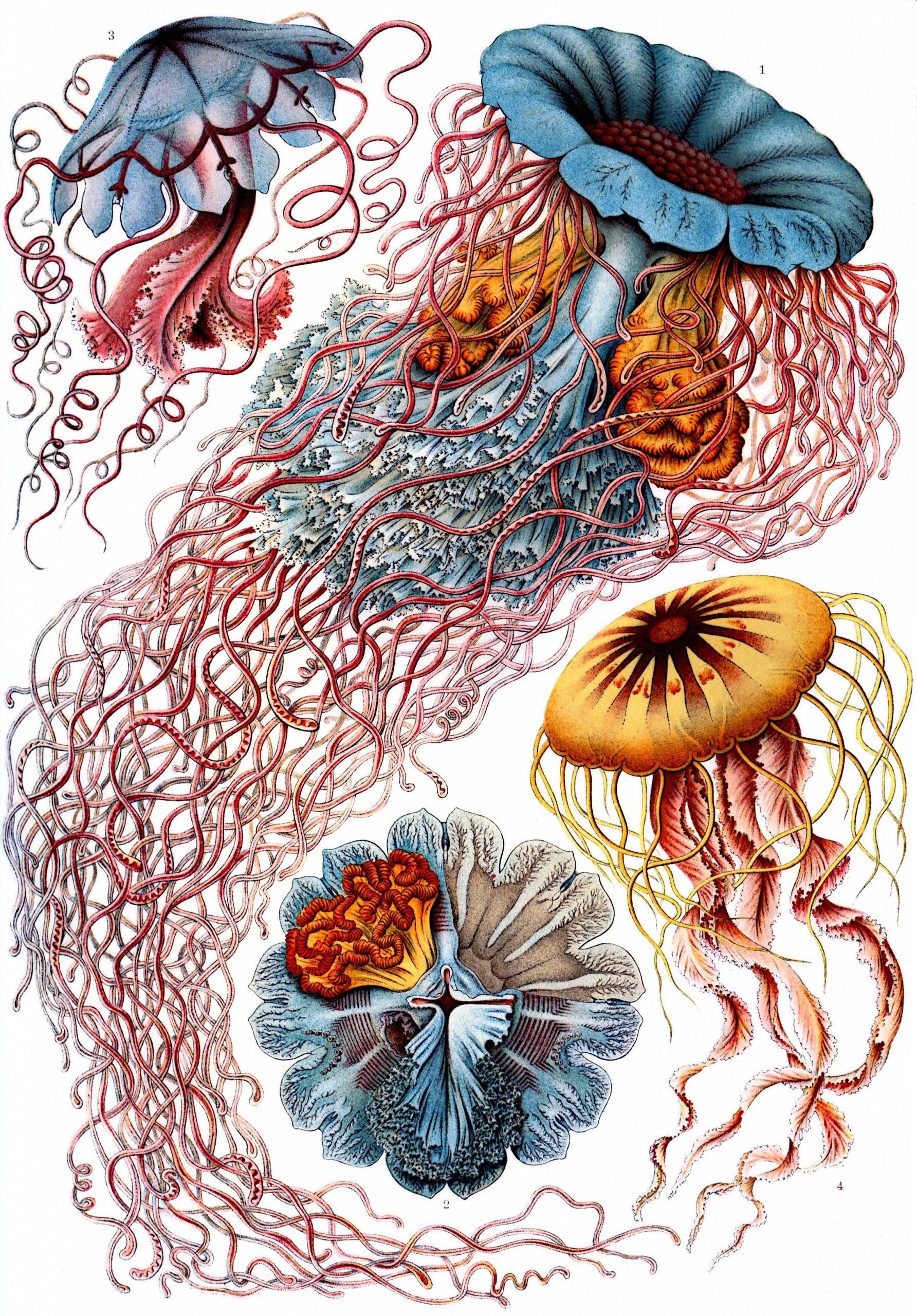31 Marine Life and the Biodiversity of the Sea
The opening of Rachel Carson’s (1950) The Sea Around Us describes the life-giving power of the sea. More than seventy years later, Carson’s powerful insights remain relevant to ongoing efforts to reverse the rampant destruction of the earth’s oceans, seas, lakes, and rivers. In recent months, there has also been renewed hope for life of the oceans, seas, and myriad water sources. Reading Carson’s book in conjunction with viewing the remarkable marine illustrations and paintings of the sea can offer students new insights in taking steps, local and global, to reverse marine pollution and protect the myriad species that are in decline. Old conceptions of the sea were inadequate, notes Carson, and new pictures continued to evolve, which continue to this day. The floor of the sea, wrote Carson, included mountain ranges that were “found to be linked to the mightiest mountains of the earth — a continuous chain encircling the globe. Deep, hidden rivers in the sea, subsurface currents with the volume of a thousand Mississippis… yet this must be considered only a beginning” for further investigation (Carson, 1989, p.viii).
Oceans and seas are life-giving forces, and yet, as Carson writes, it has undergone continuous assault. “The sea has challenged the minds and imagination of [individuals] and even today it is a realm so vast that remains the last great frontier of Earth. It is a realm so vast and so difficult of access that with all our efforts we have explored only a small fraction of its area. Not even the mighty technological developments of this, the Atomic Age have greatly changed this situation” (p.xvii). With chapter titles such as “Hidden Lands,” “The Birth of an Island,” “The Shape of Ancient Seas,” and “The Global Thermosat,” Carson invites readers to learn about the awe-inspiring complexity of the sea. Carson writes:
Beneath the sunlit surface waters of the open sea and the hidden hills and valleys of the ocean floor lies the least-known region of the sea. These deep, dark waters, with all their mysteries and their unsolved problems, cover a very considerable part of the earth. The whole world ocean extends over about three-fourths of the surface of the globe. If we subtract the shallow areas of the continental shelves and the scattered banks and shoals, here at least the pale ghost of sunlight moves over the underlying bottom, there still remains about half the earth that is covered by miles deep, lightless water, that has been dark since the world began. (p. 36).
The following art images, poems, and connecting texts highlight
Seas and Oceans in Art Images and Selected Texts
As you read the following poems and related texts and view the varied art images, you can reflect on questions such as:
- What can be done individually and collective to restore the grandeur of the rivers, lakes, seas, and oceans?
- How can marine life be restored so that it thrives rather than dies?
- How does each artist/poet/writer highlight the beauty, mystery, and power of marine environments?
- Which art image and related text did you find most interesting?
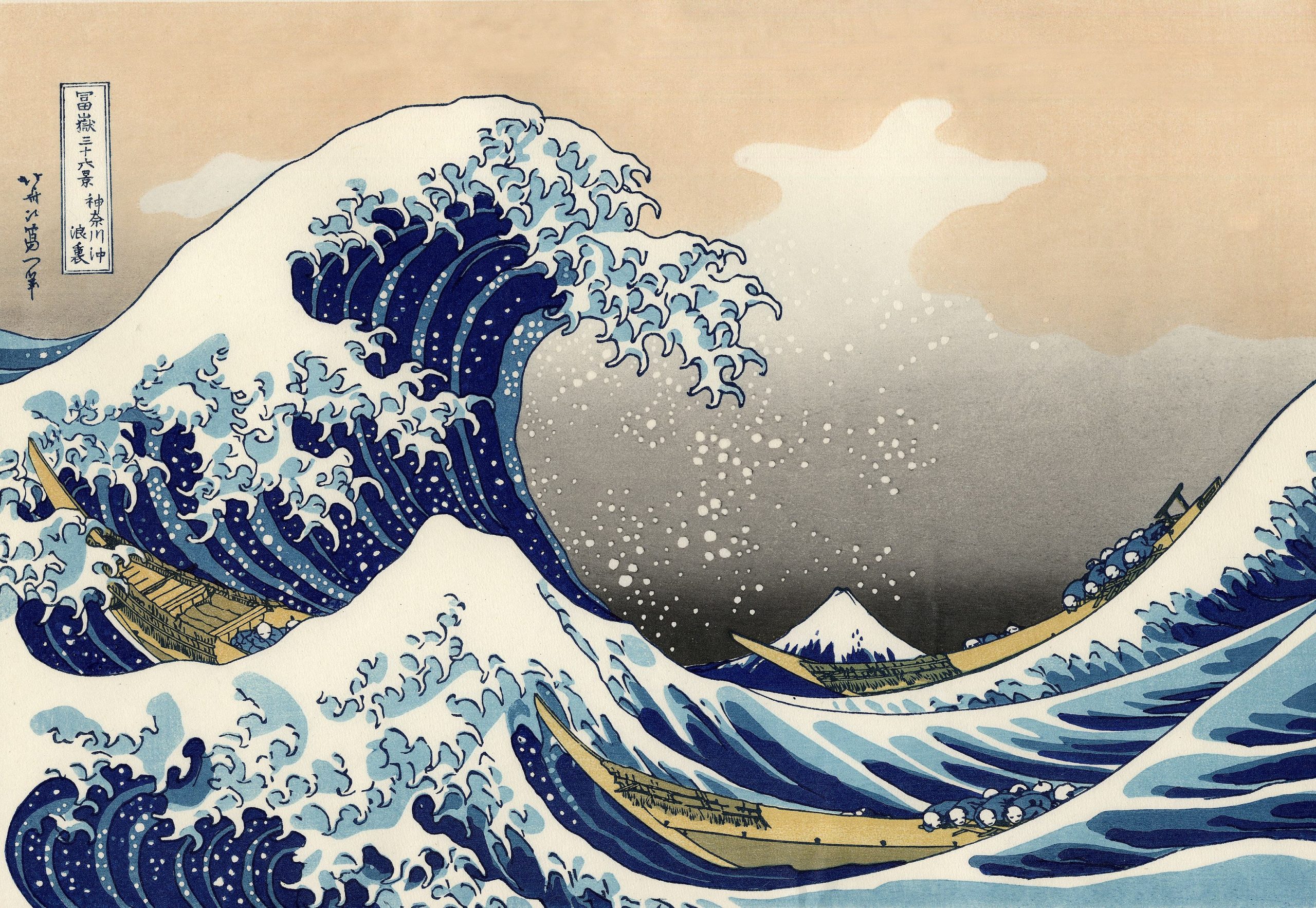
“The Brooke and the Wave” by Henry Wadsworth Longfellow
Far away in the briny ocean
There rolled a turbulent wave,
Now singing along the sea-beach,
Now howling along the cave.
“Would you learn the secret of the sea? Only those who brave its dangers, comprehend its mystery!” – Henry Wadsworth Longfellow
“The sea possesses a power over one’s moods that has the effect of a will. The sea can hypnotize. Nature in general can do so.” – Henrik Ibsen
“The ocean is a mighty harmonist.” – William Wordsworth
“Follow the river and you will find the sea.” – French Proverb
To read an article on the decline of marine life on Australian reefs, please open the link below.
“The Secret of the Sea” by Henry Wadsworth Longfellow
Ah! what pleasant visions haunt me
As I gaze upon the sea!
All the old romantic legends,
All my dreams, come back to me.
Sails of silk and ropes of sandal,
Such as gleam in ancient lore;
And the singing of the sailors,
And the answer from the shore!
Most of all, the Spanish ballad
Haunts me oft, and tarries long,
Of the noble Count Arnaldos
And the sailor’s mystic song.
Like the long waves on a sea-beach,
Where the sand as silver shines,
With a soft, monotonous cadence,
Flow its unrhymed lyric lines:—
Telling how the Count Arnaldos,
With his hawk upon his hand,
Saw a fair and stately galley,
Steering onward to the land;—
How he heard the ancient helmsman
Chant a song so wild and clear,
That the sailing sea-bird slowly
Poised upon the mast to hear,
Till his soul was full of longing,
And he cried, with impulse strong,—
“Helmsman! for the love of heaven,
Teach me, too, that wondrous song!”
“Wouldst thou,”—so the helmsman answered,
“Learn the secret of the sea?
Only those who brave its dangers
Comprehend its mystery!”
In each sail that skims the horizon,
In each landward-blowing breeze,
I behold that stately galley,
Hear those mournful melodies;
Till my soul is full of longing
For the secret of the sea,
And the heart of the great ocean
Sends a thrilling pulse through me.
A World of Beauty and Mystery
What goes on beneath the surface of the sea? The following images include beautiful and mysterious images of life beneath the oceans, seas, and rivers. How are we encouraged to respect the sea and protect marine life? What barriers stand in the way? What poems and art images would you select to express your insights into the world of oceans and seas? Which poems in this section did you find interesting and perhaps inspirational in some way?
In this section, poems, art, non-fiction excerpts, and links to essays and articles can be a catalyst for students to explore ecological themes with a focus on the seas and marine health. Students can build inquiry projects that include local initiatives that are aimed at protecting our seas, rivers, and oceans. Through poetry, literary texts, and art, students can express and explore their relationship to a changing world and in the process become advocates for positive transformative change.
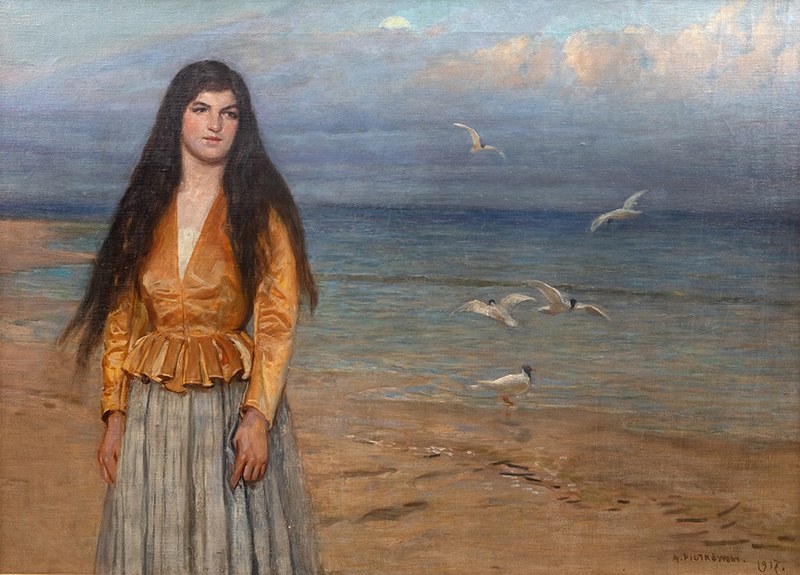
“Sea-Fever” by John Masefield
I must go down to the seas again, to the lonely sea and the sky,
And all I ask is a tall ship and a star to steer her by;
And the wheel’s kick and the wind’s song and the white sail’s shaking,
And a grey mist on the sea’s face, and a grey dawn breaking.
I must go down to the seas again, for the call of the running tide
Is a wild call and a clear call that may not be denied;
And all I ask is a windy day with the white clouds flying,
And the flung spray and the blown spume, and
the sea-gulls crying.
Excerpt from Life Lessons from the Ocean: Soothing Wisdom from the Sea (by Richard Harrington and Illustrated by Anne Davidson, 2020)
“Life began in the sea, just a few billion years ago. Now the ocean shapes our lives without us realizing it, stabilizing our climate and providing oxygen to breathe. But it gives us so much more: food, travel, fun. Just being by it influences our mood and state of mind. It has powers to refresh, given perspective and take away the pressures of life. Its untiring motion is tied with our own daily rhythms, influenced by the moon and sun. We’ve come to realize how fragile and damaged it has become, but the more we know the more we can do to repair it” (p. 5).
Shut out from heaven it makes its moan,
It frets against the boundary shore;
All earth’s full rivers cannot fill
The sea, that drinking thirsteth still.
Sheer miracles of loveliness
Lie hid in its unlooked-on bed:
Anemones, salt, passionless,
Blow flower-like; just enough alive
To blow and multiply and thrive.
Shells quaint with curve, or spot, or spike,
Encrusted live things argus-eyed,
All fair alike, yet all unlike,
Are born without a pang, and die
Without a pang, and so pass by.
A World Beneath the Waves
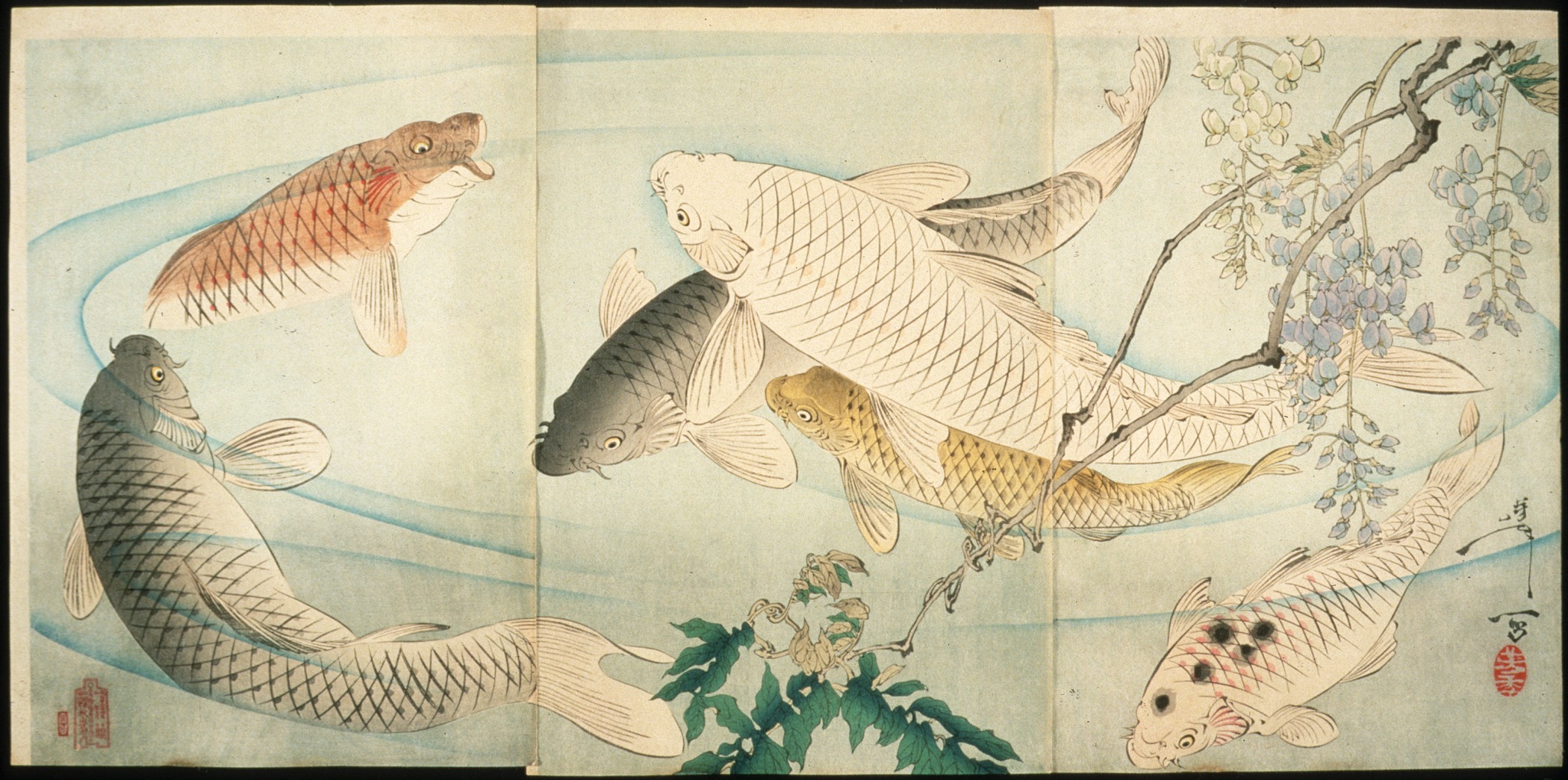
Marine Life
“Fish have been around much longer than their land-dwelling relatives. Marine life developed 3 billon years earlier than the first life on land. Lizards, frogs, insects, even dinosaurs appeared much more recently. The majority of species on Earth live in the ocean. From microscopic plankton to fearsome sharks and colossal whales, marine life includes mammals, reptiles, crustaceans, corals, plants, fungi, and microbes.” (Weiss & De Amicis, 2018, p. 16).
“The Ocean” by Nathaniel Hawthorne
The Ocean has its silent caves,
Deep, quiet, and alone;
Though there be fury on the waves,
Beneath them there is none.
The awful spirits of the deep
Hold their communion there;
And there are those for whom we weep,
The young, the bright, the fair.
The Biodiversity Heritage Library
Valuable scientific and art illustrations of marine life and the world of the oceans, seas, lakes, and rivers can be accessed throughout the Biodiversity Heritage Library (BHL). You are free to download texts and research topics of your interest. In essence, the BHL amalgamates research; it is a consortium including natural history, botanical, academic, research, and national libraries that co-operate to digitize, aggregate, and make accessible the literature of biodiversity held in their collections. Access, information, and links to additional resources can be found. Valuable texts are available for open access use as a part of a global “biodiversity commons.” Libraries worldwide are major contributors to the BHL. Researchers today use the historical scientific texts to compare changes in biodiversity patterns from the past to the present.
See the BHL home page here.
For more information about World Oceans Day please open the link here.
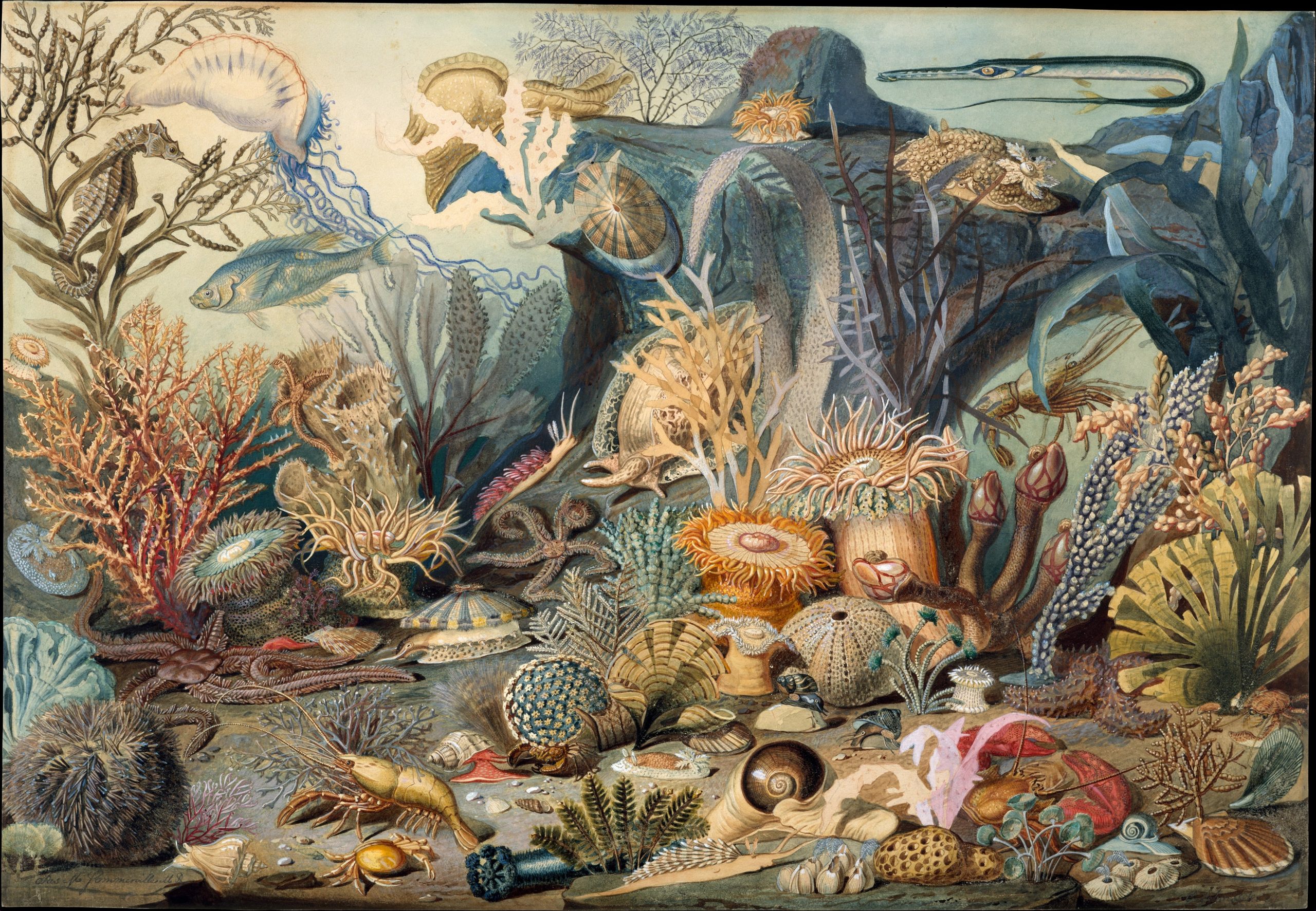
Courtesy: Gift of Mr. and Mrs. Erving Wolf, in memory of Diane R. Wolf, 1977.“https://www.metmuseum.org/art/collection/search/12544” is licensed under CC0 1.0.
Excerpt from “Ocean Life,” (The Metropolitan Museum of Art)
“Schussele, the first professor in drawing and painting at the Pennsylvania Academy of the Fine Arts, was chiefly a genre, history painter and portrait painter, yet his subject matter occasionally reflected Philadelphia’s scientific tradition, as in this watercolor. One of the earliest American submarine illustrations, this picture was executed expressly for lithographic reproduction in a pamphlet of the same title published in Philadelphia in 1859. James M. Sommerville (1825-1899), a physician, amateur naturalist, member of the Academy of Natural Sciences, as well as an artist and a trustee of the Pennsylvania Academy, was probably the designer of the watercolor. He collected the specimens, wrote the text of the pamphlet and lithographed the image.”
For further reading, please see: “It Looks Like a Shell, but an Octopus and 40,000 Eggs Live Inside” by Sofia Quaglia, The New York Times (2022)
Excerpt from A Life on Our Planet by David Attenborough with Jonnie Hughes (2022)
“The largest habitat of all is the ocean. It covers over 70per cent of the Earth’s surface but, because of its great depths, it accounts for 97 per cent of our planet’s inhabitable space. Life on Earth almost certainly began there, probably as microbes living around jets of hot water discharging from vents in the ocean floor, several kilometers below the surface. For 3 billion years, natural selection worked on such single, simple, isolated cells, refining their internal workings. It took 1.5 billion years for cells to reach a structural complexity comparable with that of the cells of which we are made, and a further 1.5 billion before such cells clumped together and worked in a coordinated way as they do in a multi-cellular organism” (p. 84).
“Seaweed” by Henry Wadsworth Longfellow
When descends on the Atlantic
The gigantic
Storm-wind of the equinox,
Landward in his wrath he scourges
The toiling surges,
Laden with seaweed from the rocks:
From Bermuda’s reefs; from edges
Of sunken ledges,
In some far-off, bright Azore;
From Bahama, and the dashing,
Silver-flashing
Surges of San Salvador;
From the tumbling surf, that buries
The Orkneyan skerries,
Answering the hoarse Hebrides;
And from wrecks of ships, and drifting
Spars, uplifting
On the desolate, rainy seas; —
Ever drifting, drifting, drifting
On the shifting
Currents of the restless main;
Till in sheltered coves, and reaches
Of sandy beaches,
All have found repose again.
So when storms of wild emotion
Strike the ocean
Of the poet’s soul, erelong
From each cave and rocky fastness,
In its vastness,
Floats some fragment of a song:
From the far-off isles enchanted,
Heaven has planted
With the golden fruit of Truth;
From the flashing surf, whose vision
Gleams Elysian
In the tropic clime of Youth;
From the strong Will, and the Endeavor
That forever
Wrestle with the tides of Fate;
From the wreck of Hopes far-scattered,
Tempest-shattered,
Floating waste and desolate; —
Ever drifting, drifting, drifting
On the shifting
Currents of the restless heart;
Till at length in books recorded,
They, like hoarded
Household words, no more depart.
Art Forms in Nature: Ernst Heinrich Phillip August Haeckel
Ernst Haeckel (1834-1919) was a German zoologist, naturalist, philosopher, professor, marine biologist, and artist. He discovered and artistically detailed thousands of new species, mapping a genealogical tree that connected all life forms. Haeckel was also a controversial figure; he was a eugenicist and popularized some of Charles Darwin’s theories that are no longer validated.
Ernst Haeckel’s most famous books, which continue to be popular, include Art Forms in Nature (1904) and The Riddle of the Universe (1901). In 2012, Prestel Publishing issued a new edition of Art Forms in Nature with 100 illustrated plates that include marine life, birds, select mammals, and amphibians. Through his artwork and scientific discoveries, Haeckel attempted to highlight the “miracle of life” in all its ecological diversity. The symmetrical and organic forms of nature are replicated in Haeckel’s art. While the richness of Haeckel’s illustrations stand out, Art Forms in Nature remains an important natural history document today. In the 2012 edition’s preface, Richard P. Hartman writes that “the book Art Forms in Nature is an epoch-making work. It was the showpiece of a respectable household and fulfilled a very particular purpose; its contents were, like nature, beautiful, for nature-according to the author-has a ‘sense of the beautiful’.”
